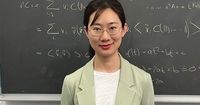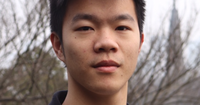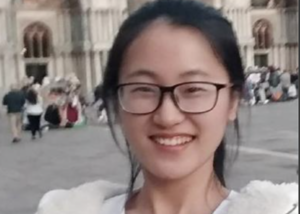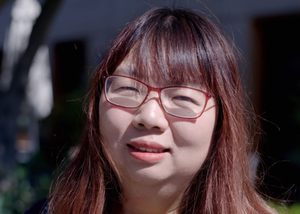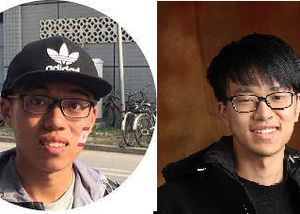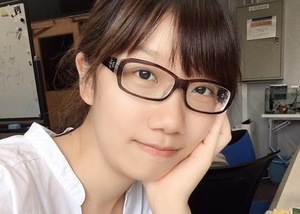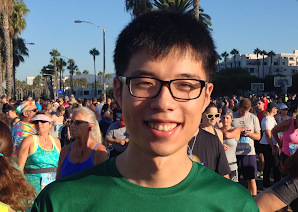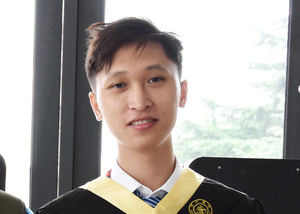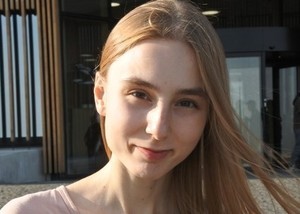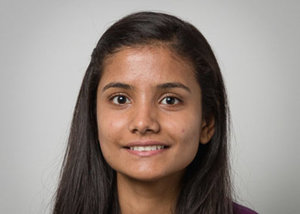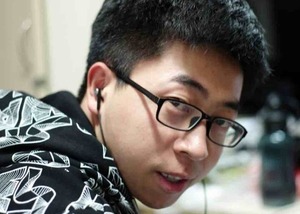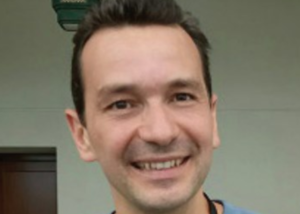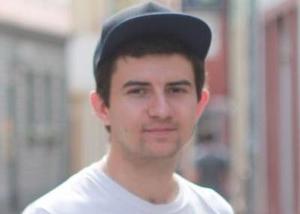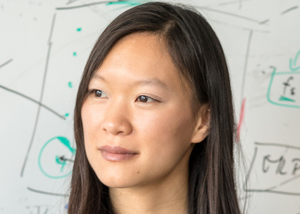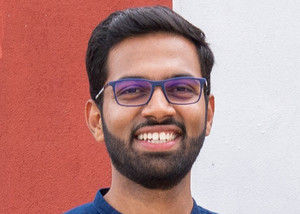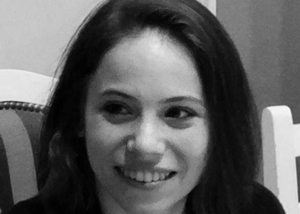Events & Talks
Perceiving Systems
Talk
Chunlu Li
19-04-2022
Model-based Face Reconstruction and Occlusion Segmentation from Weak Supervision
3D face reconstruction under occlusions is highly challenging because of the large variability of the appearance and location of occluders. Currently, the most successful methods fit a 3D face model through inverse rendering and assume a given segmentation of the occluder to avoid fitting the occluder. However, the segmentation annotations are costly since training an occlusion segmentation model requires large amounts of annotated data. To overcome this, we introduce a model-based approach for 3D face reconstruction that is highly robust to occlusions but does not require any occlusion ann...
Victoria Fernandez Abrevaya
Perceiving Systems
Talk
Angela Yao
12-04-2022
Mixing Synthetic and Real-World Captures for RGB Hand Pose Estimation
How can we learn models for hand pose estimation without any (real-world) labels? This talk presents our recent efforts in tackling the challenging scenario of learning from labelled synthetic data and unlabelled real-world data. I will focus on two strategies that we find to be effective: (1) cross-modal consistency and alignment for representation learning and (2) pseudo-label corrections and refinement.
The second part of the talk will introduce Assembly101, our newly recorded dataset that tackles 3D hand pose and action understanding over time. Assembly101 is a new procedural activit...
Dimitris Tzionas
Perceiving Systems
Talk
Henry Clever
07-04-2022
Modeling Humans at Rest with Applications to Robotic Assistance
Humans spend a large part of their lives resting. Machine perception of this class of body poses would be beneficial to numerous applications, but it is complicated by line-of-sight occlusion from bedding. Pressure sensing mats are a promising alternative, but data is challenging to collect at scale. To overcome this, we use modern physics engines to simulate bodies resting on a soft bed with a pressure sensing mat. This method can efficiently generate data at scale for training deep neural networks. We present a deep model trained on this data that infers 3D human pose and body shape from ...
Dimitris Tzionas
Chun-Hao Paul Huang
Perceiving Systems
Talk
Sida Peng
07-04-2022
Reconstructing Static Scenes and Dynamic Humans with Implicit Neural Representations
3D reconstruction is a long-standing problem in computer vision and has a variety of applications such as virtual reality, 3D content generation, and telepresence. In this talk, I will present our progress on 3D reconstruction of static scenes and dynamic humans with implicit neural representations. The first part of the talk introduces an effective regularization when optimizing implicit neural representations on indoor scenes based on the Manhattan-world Assumption. In the second part, I will show some animatable implicit neural representations for modeling dynamic humans from videos.
Hongwei Yi
Perceiving Systems
Talk
Pinelopi Papalampidi
08-02-2022
Structure-aware Narrative Understanding and Summarization
In this work, we analyze and summarize full-length movies from multimodal input (i.e., video, text, audio). We first hypothesize that identifying the narrative structure of movies is a precondition for summarizing them. According to screenwriting theory, turning points (e.g., change of plans, major setback, climax) are crucial narrative moments within a movie that define the narrative structure and determine its progression and thematic units. Therefore, we introduce the task of Turning Point (TP) identification and leverage it for movie summarization and trailer generation. Next, we propos...
Nikos Athanasiou
Chun-Hao Paul Huang
Perceiving Systems
Talk
Ye Yuan
18-01-2022
Unified Simulation, Perception, and Generation of Human Behavior
Understanding and modeling human behavior is fundamental to almost any computer vision and robotics applications that involve humans. In this talk, I will present a holistic approach to human behavior modeling and tackle its three essential aspects --- simulation, perception, and generation. I will show how the three aspects are deeply connected and how utilizing and improving one aspect can greatly benefit the other aspects.
Since humans live in a physical world, we treat simulation as the foundation of our approach and start by developing a fundamental framework for representing human ...
Hongwei Yi
Perceiving Systems
Talk
Tiantian Wang
11-01-2022
Animatable humans from monocular RGB(D) videos
We aim to reconstruct animatable humans from monocular RGB(D) videos. Learning user-controlled representation under novel poses remains a challenging problem. To tackle this problem, I will introduce two related methods. First, to reconstruct animatable photo-realistic humans, we integrate observations across frames and encode the appearance at each individual frame by utilizing the human pose and point clouds as the input. In addition, we utilize a temporal transformer to integrate the features of points in the unseen frames and the tracked points in a handful of automatically-selected key...
Arjun Chandrasekaran
Perceiving Systems
Talk
Arianna Rampini
14-12-2021
Discrete inverse spectral geometry for shape analysis
Spectral quantities as the eigenvalues of the Laplacian operator are widely used in geometry processing since they provide a very informative summary of the intrinsic geometry of deformable shapes. Typically, the intrinsic properties of shapes are computed from their representation in 3D space and are used to encode compact geometric features, thus adopting a data-reduction principle. On the contrary, this talk focuses on the inverse problem: namely, recovering an extrinsic embedding from a purely intrinsic encoding, like in the classical “hearing the shape of the drum” problem. I will sta...
Silvia Zuffi
Perceiving Systems
Talk
Yajie Zhao
10-12-2021
Next Generation Lifelike Avatar Creation
High-fidelity avatar creation for films and games is tied with complex capture equipment, massive data, a long production cycle, and intensive manual labor by a production team. And it may still be in the notorious Uncanny Valley. In this talk, we will explore how to produce a lifelike avatar in a low-cost way. We will show how to leverage deep learning networks to accelerate and simplify the industrial avatar production procedure from data capturing to animation. And bring photorealism to the next level!
Timo Bolkart
Perceiving Systems
Talk
Yandong Wen
05-10-2021
Toward Reconstructing Face from Voice
We address a new challenge posed by voice profiling - reconstructing someone’s face from their voice. Specifically, given an audio clip spoken by an unseen person, we aim to reconstruct a face that has as many associations as possible with the speaker in terms of identity. In this talk, I will introduce how we explore and approach the ultimate goal step by step. First, we investigate the audio-visual association by matching voices to faces based on identity, and vice versa. Second, we set up a baseline for reconstructing 2D face images from a voice recording and show reasonable reconstructi...
Timo Bolkart
Perceiving Systems
Talk
Yuxiang Zhang and Yang Zheng
28-09-2021
DeepMultiCap & Lightweight Multi-person Total Motion Capture Using Sparse Multi-view Cameras
We propose DeepMultiCap, a novel method for multi-person performance capture using sparse multi-view cameras. Our method can capture time varying surface details without the need of using pre-scanned template models. To tackle the serious occlusion challenge for close interacting scenes, we combine a recently proposed pixel-aligned implicit function with a parametric model for robust reconstruction of the invisible surface areas. An effective attention-aware module is designed to obtain the fine-grained geometry details from multi-view images, where high-fidelity results can be generated. I...
Chun-Hao Paul Huang
Perceiving Systems
Talk
Meng-Yu Jennifer Kuo
27-09-2021
Refraction and Absorption for Underwater Shape Recovery
In this talk the speaker will present her work on the recovery of rigid and deformable 3D shape from underwater images.
Silvia Zuffi
Perceiving Systems
Talk
Tianye Li
23-09-2021
Topologically Consistent Multi-View Face Inference Using Volumetric Sampling
High-fidelity face digitization solutions often combine multi-view stereo (MVS) techniques for 3D reconstruction and a non-rigid registration step to establish dense correspondence across identities and expressions. A common problem is the need for manual clean-up after the MVS step, as 3D scans are typically affected by noise and outliers and contain hairy surface regions that need to be cleaned up by artists. Furthermore, mesh registration tends to fail for extreme facial expressions. Most learning-based methods use an underlying 3D morphable model (3DMM) to ensure robustness, but this li...
Timo Bolkart
Perceiving Systems
Talk
Siwei Zhang
22-09-2021
Learning motion priors for 4D human body capture in 3D scenes
It is challenging to recover realistic human-scene interactions and high-quality human motions while dealing with occlusions and partial views with a monocular RGB(D) camera. We address this problem by learning motion smoothness and infilling priors from the large scale mocap dataset AMASS, to reduce the jitters, and handle contacts and occlusions, respectively. Furthermore, we combine them into a multi-stage optimization pipeline for the high quality 4D human capture in complex 3D scenes.
Chun-Hao Paul Huang
Perceiving Systems
Talk
Bharat Lal Bhatnagar
09-09-2021
Hybrid surface representations: Leveraging implicit functions and parametric models for 3D human modelling
Representing 3D humans with parametric body models (eg: SMPL) allows us to control the 3D appearance of a human with explicit parameters for pose, shape and even clothing (to an extent). Implicit function based representations on the other hand, typically lack such interpretable control but can produce more detailed models as compared to parametric approaches. They also are not constrained by topology and resolution. In this talk I would like to discuss how we can combine these two directions and leverage the best of both worlds to model detailed and controllable 3D humans.
I will primari...
Ahmed Osman
Arjun Chandrasekaran
Perceiving Systems
Talk
Jiefeng Li
06-09-2021
From skeleton to body: Keypoint Estimation is Helpful for Human Body Reconstruction
My works mainly lie in inferring human structures from RGB inputs, which starts from 2D keypoint estimation, towards more complex tasks like 3D skeleton inference and SMPL-based human pose & shape estimation. Along this road, we find that high-level tasks, like human body estimation, can benefit a lot from low-level inferred structures, like 3D skeletons, and vice versa. Furthermore, in our latest work, "Human Pose Regression with Residual Log-likelihood Estimation", we unified all the above HPS tasks in a direct regression paradigm, replacing generally accepted heatmap without loss of accu...
Yuliang Xiu
Perceiving Systems
Talk
Davis Rempe
27-07-2021
Modeling 3D Human Motion for Improved Pose Estimation
Though substantial progress has been made in estimating 3D human poses from dynamic observations, recent methods still struggle to recover physically-plausible motions, and the presence of noise and occlusions remains challenging. In this talk, I'll introduce two methods that tackle these issues by leveraging models of 3D human motion - one physics-based and one learned. In the first approach, an initial 3D motion is refined using a physics-based trajectory optimization that leverages automatically-detected foot contacts from RGB video. In the second, a learned generative model is used as a...
Muhammed Kocabas
Perceiving Systems
Talk
Hao Li
26-07-2021
AI SYNTHESIS: FROM AVATARS TO 3D SCENES
In this talk I will motivate how digital humans will impact the future of communication, human-machine interaction, and content creation. I will present our latest 3D avatar digitization technology from Pinscreen from a single photo, and give a live demonstration. I will also showcase how we use hybrid CG and neural rendering solutions for real-time applications used in next generation virtual assistant and virtual production pipelines. I will then present a real-time teleportation system that only uses a single webcam as input, and our latest efforts at UC Berkeley in real-time AI synthesi...
Yao Feng
Perceiving Systems
Talk
Maria Kolos
14-07-2021
TRANSPR: Transparency Ray-Accumulating Neural 3D Scene Point Renderer
We propose and evaluate a neural point-based graphics method that can model semi-transparent scene parts. Similarly to its predecessor pipeline, ours uses point clouds to model proxy geometry, and augments each point with a neural descriptor. Additionally, a learnable transparency value is introduced in our approach for each point.
Our neural rendering procedure consists of two steps. Firstly, the point cloud is rasterized using ray grouping into a multi-channel image. This is followed by the neural rendering step that "translates" the rasterized image into an RGB output using a learnable ...
Qianli Ma
Perceiving Systems
Talk
Nataniel Ruiz
14-06-2021
Using Generative Models for Faces to Test Neural Networks
Most machine learning models are validated on fixed datasets. This can give an incomplete picture of the capabilities and weaknesses of the model. Such weaknesses can be revealed at test time in the real world with dire consequences. In order to alleviate this issue, simulators can be controlled in a fine-grained manner using interpretable parameters to explore the semantic image manifold and discover such weaknesses before deploying a model. Also, in recent years there have been important advances in generative models for computer vision resulting in realistic face generation and manipulat...
Timo Bolkart
Perceiving Systems
Talk
Peizhuo Li
10-06-2021
Learning Skeletal Articulations with Neural Blend Shapes
Animating a newly designed character using motion capture (mocap) data is a long standing problem in computer animation. A key consideration is the skeletal structure that should correspond to the available mocap data, and the shape deformation in the joint regions, which often requires a tailored, pose-specific refinement. In this work, we develop a neural technique for articulating 3D characters using enveloping with a pre-defined skeletal structure which produces high quality pose dependent deformations. Our framework learns to rig and skin characters with the same articulation structure...
Hongwei Yi
Perceiving Systems
Talk
Marc Habermann
01-06-2021
Real-time Deep Dynamic Characters
Animatable and photo-realistic virtual 3D characters are of enormous importance nowadays. However, generating realistic characters still requires manual intervention, expensive equipment, and the resulting characters are either difficult to control or not realistic. Therefore, the goal of the work, that is presented within the talk, is to learn digital characters which are both realistic and easy to control and can be learned directly from a multi-view video. To this end, I will introduce a deep videorealistic 3D human character model displaying highly realistic shape, motion, and dynamic a...
Yinghao Huang
Chun-Hao Paul Huang
Perceiving Systems
Talk
Chloe LeGendre
11-05-2021
Lighting Virtual Objects using Machine Learning
Compositing rendered, virtual objects into photographs or videos is a fundamental technique in mixed reality, visual effects, and film production. For truly convincing and seamless composites, the subjects must be rendered with lighting that matches that of the target footage. For instance, a rendered object that is too bright, too dark, or lit from a direction inconsistent with other objects in the scene will look out of place. As such, in this talk I will introduce two recent machine learning based approaches for lighting estimation used for improving the realism of augmented reality (AR)...
Victoria Fernandez Abrevaya
Perceiving Systems
Talk
Justus Thies
15-04-2021
Neural Capture & Synthesis
The main theme of my work is to capture and to (re-)synthesize the real world using commodity hardware. It includes the modeling of the human body, tracking, as well as the reconstruction and interaction with the environment. The digitization is needed for various applications in AR/VR as well as in movie (post-)production. Teleconferencing and remote collaborative working in VR is of high interest since it is the next evolution step of how people communicate. A realistic reproduction of appearances and motions is key for such applications. Capturing natural motions and expressions as well ...
Ahmed Osman
Perceiving Systems
Talk
Gyeongsik Moon
12-04-2021
Expressive Whole-Body 3D Multi-Person Pose and Shape Estimation from a Single Image
Human is the most centric and interesting object in our life: many human-centric techniques and studies have been proposed from both industry and academia, such as virtual try-on, 3D personal avatar, and marker-less motion capture in the movie/game industry, including AR/VR. Recovery of accurate 3D geometry of humans (i.e., 3D human pose and shape) is a key component of the human-centric techniques and studies. In particular, the 3D pose and shape of multiple persons can deliver relative 3D location between persons. Also, the 3D pose and shape of the whole body, which includes hands and fac...
Chun-Hao Paul Huang
Perceiving Systems
Talk
Angjoo Kanazawa
08-04-2021
Pushing the Boundaries of Novel View Synthesis
2020 was a turbulent year, but for 3D learning it was a fruitful one with lots of exciting new tools and ideas. In particular, there have been many exciting developments in the area of coordinate
based neural networks and novel view synthesis. In this talk I will discuss our recent work on single image view synthesis with pixelNeRF, which aims to predict a Neural Radiance Field (NeRF) from a single image. I will discuss how NeRF representation allows models like pixel-aligned implicit functions (PiFu) to be trained without explicit 3D supervision and the importance of other key design fact...
Qianli Ma
Perceiving Systems
Talk
Meng Zhang
01-04-2021
Hair & garment synthesis using deep learning method
For both AR and VR applications, there is a strong motivation to generate virtual avatars with realistic hairs and garments that are the two most significant elements to personify any character. However, due to the complex structures and ever-changing fashion styles, modeling hairs and garments still remain tedious and expensive as they require considerable professional effort. My research interest focuses on deep learning methods in 3D modeling, rendering, and animation, especially to synthesis high-quality hairs and garments with plausible details. In this talk, I will present the progres...
Jinlong Yang
Perceiving Systems
Talk
Garvita Tiwari
25-02-2021
Learning Size-Sensitive Clothing Model From Real Data
3D Human modeling has numerous applications in AR/VR, entertainment, the fashion industry and has been a challenging task, due to variation in human motion, body shape, style of clothing. One of the main challenges in human modeling is clothing, because of the complex behavior of clothing in the real world, lack of large scale dataset, etc. In this talk, I will talk about the motivation of learning from real-world data and present my previous work on size sensitive clothing model and 3d clothing parsing.
Perceiving Systems
Talk
Leonidas Guibas
22-02-2021
Joint Learning Over Visual and Geometric Data
Many challenges remain in applying machine learning to domains where obtaining massive annotated data is difficult. We discuss approaches that aim to reduce supervision load for learning algorithms in the visual and geometric domains by leveraging correlations among data as well as among learning tasks -- what we call joint learning. The basic notion is that inference problems do not occur in isolation but rather in a "social context" that can be exploited to provide self-supervision by enforcing consistency, thus improving performance and increasing sample efficiency. An example is voting ...
Qianli Ma
Perceiving Systems
Talk
Ruilong Li
10-02-2021
AI Choreographer: Learn to dance with AIST++
In this work, we present a transformer-based learning framework for 3D dance generation conditioned on music. We carefully design our network architecture and empirically study the keys for obtaining qualitatively pleasing results. In addition, we propose a new dataset of paired 3D motion and music called AIST++, which contains 1.1M frames of 3D dance motion in 1408 sequences, covering 10 genres of dance choreographies and accompanied with multi-view camera parameters. To our knowledge it is the largest dataset of this kind.
Yuliang Xiu
Perceiving Systems
Talk
Shruti Agarwal
28-01-2021
Creating, Weaponizing, and Detecting Deep Fakes
The past few years have seen a startling and troubling rise in the fake-news phenomena in which everyone from individuals to nation-sponsored entities can produce and distribute misinformation. The implications of fake news range from a misinformed public to an existential threat to democracy, and horrific violence. At the same time, recent and rapid advances in machine learning are making it easier than ever to create sophisticated and compelling fake images, videos, and audio recordings, making the fake-news phenomena even more powerful and dangerous. These AI-synthesized media (so-called...
Jinlong Yang
Perceiving Systems
Talk
Yixin Chen
27-01-2021
Towards a more holistic understanding of scene, object, and human
Humans, even young infants, are adept at perceiving and understanding complex indoor scenes. Such an incredible vision system relies on not only the data-driven pattern recognition but also roots from the visual reasoning system, known as the core knowledge, that facilitates the 3D holistic scene understanding tasks. This talk discusses how to employ physical common sense and human-object interaction to bridge scene and human understanding and how the part-level 3D affordance perception may lead to a more fine-grained human-object interaction modeling. Future directions may be extended to d...
Dimitris Tzionas
Perceiving Systems
Talk
Zorah Lähner
21-01-2021
Non-Rigid Shape Correspondence through Deformation
Solving for 3D correspondences beyond isometries has made tremendous progress in recent years, much of it due to (deep) learning. However, not all applications provide the necessary training data. This talk will focus on how far we can take the results without learning. I will present a line of work that poses the non-rigid shape registration problem in terms of physical and non-physical deformation energies. Our work aims to combine extrinsic and intrinsic measures to overcome typical shortcomings of both. We use Functional Maps and Markov Chain Monte Carlo initialization to handle all kin...
Jinlong Yang
Perceiving Systems
Talk
Raquel Urtasun
14-12-2020
A Future with Self-Driving Vehicles
We are on the verge of a new era in which robotics and artificial intelligence will play an important role in our daily lives. Self-driving vehicles have the potential to redefine transportation as we understand it today. Our roads will become safer and less congested, while parking spots will be repurposed as leisure zones and parks. However, many technological challenges remain as we pursue this future.
In this talk I will showcase the latest advancements made by Uber Advanced Technologies Group’s in the quest towards self-driving vehicles at scale.
Qianli Ma
Perceiving Systems
Talk
Daniel Haun
05-10-2020
The phenotyping revolution
One of the most striking characteristics of human behavior in contrast to all other animal is that we show extraordinary variability across populations. Human cultural diversity is a biological oddity. More specifically, we propose that what makes humans unique is the nature of the individual ontogenetic process, that results in this unparalleled cultural diversity. Hence, our central question is: How is human ontogeny adapted to cultural diversity and how does it contribute to it? This question is critical, because cultural diversity does not only entail our predominant mode of adaptation ...
Timo Bolkart
Perceiving Systems
Talk
Noah Snavely
02-10-2020
Reconstructing the Plenoptic Function
Imagine a futuristic version of Google Street View that could dial up any possible place in the world, at any possible time. Effectively, such a service would be a recording of the plenoptic function—the hypothetical function described by Adelson and Bergen that captures all light rays passing through space at all times. While the plenoptic function is completely impractical to capture in its totality, every photo ever taken represents a sample of this function. I will present recent methods we've developed to reconstruct the plenoptic function from sparse space-time samples of photos—inclu...
Perceiving Systems
Talk
Daniel Holden
10-08-2020
Functions, Machine Learning, and Game Development
Game Development requires a vast array of tools, techniques, and expertise, ranging from game design, artistic content creation, to data management and low level engine programming. Yet all of these domains have one kind of task in common - the transformation of one kind of data into another. Meanwhile, advances in Machine Learning have resulted in a fundamental change in how we think about these kinds of data transformations - allowing for accurate and scalable function approximation, and the ability to train such approximations on virtually unlimited amounts of data. In this talk I will p...
Abhinanda Ranjit Punnakkal
Perceiving Systems
Talk
Vittorio Ferrari
07-08-2020
Our Recent Research on 3D Deep Learning
I will present three recent projects within the 3D Deep Learning research line from my team at Google Research: (1) a deep network for reconstructing the 3D shape of multiple objects appearing in a single RGB image (ECCV'20). (2) a new conditioning scheme for normalizing flow models. It enables several applications such as reconstructing an object's 3D point cloud from an image, or the converse problem of rendering an image given a 3D point cloud, both within the same modeling framework (CVPR'20); (3) a neural rendering framework that maps a voxelized object into a high quality image. It re...
Yinghao Huang
Arjun Chandrasekaran
Perceiving Systems
Talk
Antonio Torralba
28-07-2020
Learning from vision, touch and audition
Babies learn with very little supervision, and, even when supervision is present, it comes in the form of an unknown spoken language that also needs to be learned. How can kids make sense of the world? In this work, I will show that an agent that has access to multimodal data (like vision, audition or touch) can use the correlation between images and sounds to discover objects in the world without supervision. I will show that ambient sounds can be used as a supervisory signal for learning to see and vice versa (the sound of crashing waves, the roar of fast-moving cars – sound conveys impor...
Arjun Chandrasekaran
Perceiving Systems
Talk
Artsiom Sanakoyeu
22-07-2020
Learning Dense Correspondences for Animals with limited supervision and Improving Generalization for Deep Metric Learning
Learning the embedding space, where semantically similar objects are located close together and dissimilar objects far apart, is a cornerstone of many computer vision applications. Existing approaches usually learn a single metric in the embedding space for all available data points,which may have a very complex non-uniform distribution with different notions of similarity between objects, e.g. appearance, shape, color or semantic meaning. We approach this problem by using the embedding space more efficiently by jointly splitting the embedding space and data into K smaller sub-problems. It ...
Nikos Athanasiou
Perceiving Systems
Talk
Angela Dai
16-07-2020
Towards Commodity 3D Scanning for Content Creation
In recent years, commodity 3D sensors have become widely available, spawning significant interest in both offline and real-time 3D reconstruction. While state-of-the-art reconstruction results from commodity RGB-D sensors are visually appealing, they are far from usable in practical computer graphics applications since they do not match the high quality of artist-modeled 3D graphics content. One of the biggest challenges in this context is that obtained 3D scans suffer from occlusions, thus resulting in incomplete 3D models. In this talk, I will present a data-driven approach towards genera...
Yinghao Huang
Perceiving Systems
Talk
William T. Freeman
13-07-2020
Learning from videos played forwards, backwards, fast, and slow
How can we tell that a video is playing backwards? People's motions look wrong when the video is played backwards--can we develop an algorithm to distinguish forward from backward video? Similarly, can we tell if a video is sped-up?
We have developed algorithms to distinguish forwards from backwards video, and fast from slow. Training algorithms for these tasks provides a self-supervised task that facilitates human activity recognition. We'll show these results, and applications of these unsupervised video learning tasks, including a method to change the timing of people in videos.
Yinghao Huang
Perceiving Systems
Talk
Matthias Nießner
10-07-2020
Learning Non-rigid Optimization
Applying data-driven approaches to non-rigid 3D reconstruction has been difficult, which we believe can be attributed to the lack of a large-scale training corpus. One recent approach proposes self-supervision based on non-rigid reconstruction. Unfortunately, this method fails for important cases such as highly non-rigid deformations. We first address this problem of lack of data by introducing a novel semi-supervised strategy to obtain dense interframe correspondences from a sparse set of annotations. This way, we obtain a large dataset of 400 scenes, over 390,000 RGB-D frames, and 2,537 d...
Vassilis Choutas
Perceiving Systems
Talk
Dushyant Mehta
02-07-2020
Real-time Multi-person 3D Motion Capture with a Single RGB Camera
In our recent work, XNect, we propose a real-time solution for the challenging task of multi-person 3D human pose estimation from a single RGB camera. To achieve real-time performance without compromising on accuracy, our approach relies on a new efficient Convolutional Neural Network architecture, and a multi-staged pose formulation. The CNN architecture is approx. 1.3x faster than ResNet-50, while achieving the same accuracy on various tasks, and the benefits extend beyond inference speed to a much smaller training memory footprint and a much higher training throughput. The proposed pose ...
Yinghao Huang
Perceiving Systems
Talk
Scott Eaton
12-06-2020
Artists+AI: Figures, Form and other Fantastical Experiments in Deep Learning
In this visual feast, Scott recounts results and revelations from four years of experimentation using machine learning as a ‘creative collaborator’ in his artistic process. He makes the case that AI, rather than rendering artists obsolete, will empower us and expand our creative horizons.
In this visual feast, Scott shares an eclectic range of successes and failures encountered in his efforts to create powerful, but artistically controllable neural networks to use as tools to represent and abstract the human figure. Scott also gives a behinds-the-scenes look at creating the work for his...
Ahmed Osman
Perceiving Systems
Talk
Srinath Sridhar
10-06-2020
Canonicalization for 3D Perception
In this talk, I will introduce the notion of 'canonicalization' and how it can be used to solve 3D computer vision tasks. I will describe Normalized Object Coordinate Space (NOCS), a 3D canonical container that we have developed for 3D estimation, aggregation, and synthesis tasks. I will demonstrate how NOCS allows us to address previously difficult tasks like category-level 6DoF object pose estimation, and correspondence-free multiview 3D shape aggregation. Finally, I will discuss future directions including opportunities to extend NOCS for tasks like articulated and non-rigid shape and po...
Timo Bolkart
Perceiving Systems
Talk
Will Smith
15-05-2020
Deep inverse rendering in the wild
In this talk I will consider the problem of scene-level inverse rendering to recover shape, reflectance and lighting from a single, uncontrolled, outdoor image. This task is highly ill-posed, but we show that multiview self-supervision, a natural lighting prior and implicit lighting estimation allow an image-to-image CNN to solve the task, seemingly learning some general principles of shape-from-shading along the way. Adding a neural renderer and sky generator GAN, our approach allows us to synthesise photorealistic relit images under widely varying illumination. I will finish by briefly de...
Timo Bolkart
Perceiving Systems
Talk
Aayush Bansal
14-05-2020
Computational Studio: A computational machinery to enhance social communication
Licklider and Taylor (1968) envisioned computational machinery that could enable better communication between humans than face-to-face interaction. In the last fifty years, we have used computing to develop various means of communication, such as mail, messaging, phone calls, video conversation, and virtual reality. These are, however, a proxy of face-to-face communication that aims at encoding words, expressions, emotions, and body language at the source and decoding them reliably at the destination. The true revolution of personal computing has not begun yet because we have not been able ...
Arjun Chandrasekaran
Chun-Hao Paul Huang
Perceiving Systems
Talk
Chunyu Wang
16-04-2020
Handling Occlusion by Cross View Fusion for 3D Human Pose Estimation
Accurate 3D human pose estimation has been a longstanding goal in computer vision. However, till now, it has only gained limited success in easy scenarios such as studios which have little occlusion. In this talk, I will present our two works aiming to address the occlusion problem in realistic scenarios.
In the first work, we present an approach to recover absolute 3D human pose of single person from multi-view images by incorporating multi-view geometric priors in our model. It consists of two separate steps: (1) estimating the 2D poses in multi-view images and (2) recovering the 3D po...
Chun-Hao Paul Huang
Perceiving Systems
Talk
Victoria Fernández Abrevaya
26-03-2020
Learning to Model 3D Human Face Geometry
In this talk I will present an overview of our recent works that learn deep geometric models for the 3D face from large datasets of scans. Priors for the 3D face are crucial for many applications: to constrain ill posed problems such as 3D reconstruction from monocular input, for efficient generation and animation of 3D virtual avatars, or even in medical domains such as recognition of craniofacial disorders. Generative models of the face have been widely used for this task, as well as deep learning approaches that have recently emerged as a robust alternative. Barring a few exceptions, mos...
Jinlong Yang
